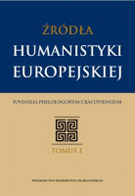Postać świętej dziwki w Zbrodni i karze Fiodora Dostojewskiego. Przyczynek do antropologii kobiety
The Figure of the Holy Whore in Fyodor Dostoevsky’s Crime and Punishment
Author(s): Maciej PiątekSubject(s): Literary Texts
Published by: Wydawnictwo Uniwersytetu Jagiellońskiego
Keywords: literatura współczesna; literatura klasyczna; humanistyka; żródła literackie; żródła języka; dziedzictwo kulturowe; kultura europejska; humanizm
Summary/Abstract: The article is an interpretation of Fyodor Dostoevsky’s Crime and Punishment with particular emphasis on the character of Sonya. The context of my reading comprises the practice of sacred prostitution in antiquity as reported by Herodotus and interpreted in modern texts, Kabala and its erotic language as well as Bakhtin’s readings of Dostoevsky’s novels. The sacred prostitute in Middle East temples acted as an intermediary between human reality and divine world, the literary language of kabalistic writings describes mystical union with God in overtly sexual terms, and Dostoevsky merges those two motifs—of erotic ritual and erotic language—in the scene depicting Sonya’s reading of the Gospel to Raskolnikov. Body and language become—metaphorically speaking—an uncanny locus of intersection between the sacred and the profane, the human and the divine. My general aim is to show that Sonya’s sinful profession functions as a complex metaphor which can be very well elucidated by setting it in the context of the temple rituals of antiquity and the book of Zohar, a principal text of medieval Kabala. While her eloquent body speaks the holy word, and the word itself becomes (her) flesh, she is transformed into a medium connecting the two realities. The little room where Sonya and Raskolnikov meet becomes a mysterious place of communion/communication, when Sonya gives herself to the holy word and—metaphorically—to Raskolnikov at the same time. This transgression results in an erasure of self, so typical for the prostitute’s profession (that is why this profession can function as a metaphor in the novel), and forms the condition for an authentic meeting between the two characters. A close reading of Sonya’s reading of the Gospel reveals that she is a Beatrice in the brothel and makes her a symbol of deeply paradoxical feminine nature.
Journal: Źródła humanistyki europejskiej. Iuvenilia Philologorum Cracoviensium
- Issue Year: 2011
- Issue No: 3
- Page Range: 165-174
- Page Count: 10
- Language: Polish

